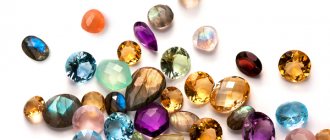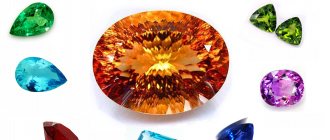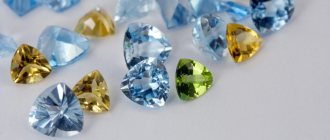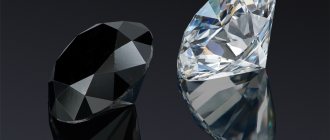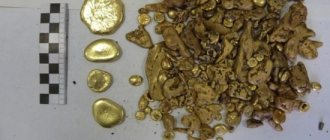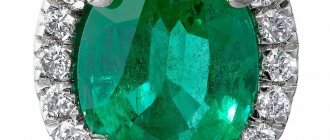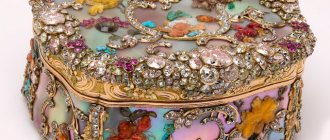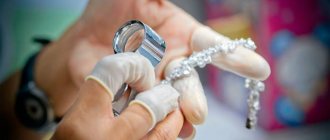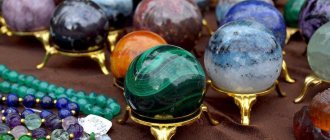Any precious and semi-precious stone is subject to high requirements, compliance with which determines the final cost of the stone and the jewelry adorned with it. Sapphires, one of the most expensive and beautiful minerals, are no exception. There are 4 generally accepted parameters by which the quality of sapphire can be determined.
Color
One of the main indicators of the quality of sapphires is the depth and richness of their shade. For blue stones, the reference shade is the shade of Kashmir corundum, pure cornflower blue. For fancy corundums, that is, those colored in colors other than red, there is no generally accepted standard.
To determine the color indicators of a mineral, professionals use special tables; the color is determined visually, without the use of instruments. This characteristic of sapphire has three components: tone, saturation and lightness. Interestingly, the last parameter is valued differently in different countries. Thus, dark corundums are more popular in Russia, while light corundums are more popular in Europe.
There are five categories of lightness and three of saturation; shades are usually divided according to the spectrum, but to simplify the classification in commerce, three names are used: bright (1), medium (2) and light (3) blue.
How to wear and care for sapphire
Astrologers advise buying jewelry on the 8th lunar day, and putting it on for the first time on the 22nd. On which finger to wear a sapphire ring? On the index hand of the right hand, then the stone will maximize its best properties: bring good luck, prosperity, make a person wiser and more resilient.
An engagement ring with blue corundum will bring good luck in your family life. In case of an accidental disagreement with your spouse, you need to put a ring on the ring finger of your right hand so that the problem goes away.
For men, large rings, matching cufflinks, and tie pins with a dark-colored stone are suitable.
Brunettes look good with deep blue stones, while blondes look good with light ones.
A modest ring with a medium-sized sapphire placed on your finger looks appropriate in the office. It can be set in silver or white gold. For special occasions, large jewelry is chosen.
For a piece of jewelry to delight its owner with its pristine beauty for many years, little is required:
- avoid falling stones, any strong mechanical impact, interaction with chemicals, cosmetics;
- remove jewelry when performing household chores (laundry, washing dishes, cooking);
- do not swim in it, do not stay in direct sunlight for a long time;
- store separately from other jewelry in a box upholstered in soft fabric;
- clean with a soft cloth in a soap or saline solution, then rinse with clean water.
With proper care and careful storage, the precious jewelry will become a family heirloom and will be gratefully received by the heirs.
Purity
The purity of sapphire is an important characteristic that affects the value and quality indicators of corundum. How to determine purity? First, it is determined by eye, and then a tenfold magnifying glass is used in order to study in more detail all the features of a particular specimen. The purity of a stone also means its transparency: these concepts are equivalent to each other. Below is a classification table that includes a description of the properties of stones, dividing them into four categories according to the level of purity and transparency.
| Category | Properties |
| 1 | Stones belonging to the first category have an almost perfect transparency. There are no serious defects inside, but there may be small inclusions that will only be noticeable upon detailed examination with a magnifying glass. Usually this doesn't matter much. The first category includes specimens of high value and purest color. |
| 2 | A sapphire stone of the second category can also be called transparent, but its color is more saturated, and the internal structure is characterized by the presence of defects and inclusions that are not visible under a magnifying glass. This means that the quality of sapphire of the 2nd category is not bad, but it may cost a little less than the stones of the first category. |
| 3 | Sapphire 3/3, or third category, is a completely opaque corundum, which has defects and inclusions inside, visible to the naked eye. You can also purchase this type of stone; as a rule, it’s not only a matter of price, but also of taste preferences, which can be different. |
| 4 | The characteristics of sapphire of the fourth category are low transparency, immediately noticeable defects, and uncertainty of color. Such stones can be quite cloudy, and their cost is much lower than that of representatives of the first two categories. |
When determining, it is important to consider that there is no other “scheme” that could be applied specifically to sapphire. Fraudsters or unprofessional sellers can sometimes use the IF category for advertising purposes and apply it to corundum, designating individual specimens as “a stone of perfect purity and transparency.” However, keep in mind that in reality, category IF, approved by one of the leading gemological institutes in the United States, has nothing to do with sapphires: “perfectly pure” corundum simply does not occur in the natural environment. Read about methods of refining sapphires here →
What does the concept of “sapphire quality” mean? This is a combination of color and purity indicators. Thus, a 3/3 sapphire (where the first number is color, the second is clarity) is of lower quality than a 1/1 stone.
How to choose a sapphire stone of decent quality? If you know about the four categories that determine its purity, you will have a much easier time completing this task. I would like to note right away that in some cases you may not need additional magnification. However, in order to choose the right sapphire, the characteristics of which will be the most worthy, you can carry a magnifying glass with you to exhibitions and sales of precious stones and use its help at any time.
Read also about diamond purity →
Basic quality parameters
The rule of four “Cs” for determining the value of a sapphire is based on the most important characteristics of the stone, the name of which in English sounds begins with this letter:
- Clarity;
- Colour;
- Cut;
- Carat weight.
In Russian, these words successively mean color, clarity, cut and weight (carat). The first two parameters are determined by the jeweler visually, that is, by eye. This uses a magnifying glass to increase visibility. For an experienced gemologist, tenfold magnification is enough to discern possible defects in the stone.
The main physical characteristics of sapphire include glassy luster, a hardness value of 9 units (Mohs), and the absence of cleavage in crystals. The latter indicator affects the appearance of the fracture. On the surface formed when the mineral is split, a shape similar to a bivalve mollusk shell is clearly visible.
In the article “Chemical formula of sapphire and its physical properties” you will find additional information.
Cut
The cut of a sapphire and the method of processing the gemstone depend on its internal structure. As you know, there are different types of corundum, to which one or another cutting method can be applied.
In some cases, professional cutters use a method called cabochon:
- if the mineral belongs to the so-called star-shaped;
- if the sapphire has a large number of foreign inclusions or other defects that interfere with the classical cut.
In the first case, we are talking about the effect of asterism, when, after polishing, a star appears on the surface of a stone turned at a certain angle. In the case of sapphires, it will be 6- or 12-rayed. This effect is exhibited by varieties of minerals that contain needle-shaped rutile inclusions located at an angle to the surface. Asterism significantly increases the value of corundum.
Sapphires that do not have noticeable inclusions and are not capable of asterism are cut in the usual, faceted way: the stone can be given a round or oval shape, or made pear-shaped. Any colorless and seemingly unremarkable stone will become much more attractive after conventional processing.
Carat
The weight of precious stones, including sapphires, is measured in carats. 1 carat is equal to 0.2 grams. But how can you understand how much a mineral in a piece of jewelry weighs if you can’t check it separately on a jewelry scale? You can measure its size.
Carat table for sapphires of the three most popular cuts:
| Round | Oval | Pear | |||
| mm | carats | mm | carats | mm | carats |
| 1 | 0,01 | 5×3 | 0,35 | 5×3 | 0,30 |
| 2 | 0,05 | 6×4 | 0,60 | 6×4 | 0,50 |
| 3 | 0,15 | 7×5 | 1,00 | 7×5 | 0,85 |
| 4 | 0,34 | 8×6 | 1,55 | 8×5 | 1,05 |
| 5 | 0,60 | 9×7 | 2,20 | 9×6 | 1,85 |
| 6 | 1,05 | 10×8 | 3,15 | 10×7 | 2,50 |
| 7 | 1,70 | 11×9 | 3,80 | ||
| 8 | 2,30 | 12×10 | 6,00 | ||
| 10 | 4,75 | ||||
If you are not purchasing jewelry from a trusted seller, and there is a suspicion that a sapphire that is too small in size weighs 2, 4, 6 carats, etc., as indicated on the tag, use a ruler and table.
PHYSICAL PROPERTIES
| Mineral color | blue and cyan in various shades |
| Stroke color | white |
| Transparency | opaque to transparent |
| Shine | glass |
| Cleavage | No |
| Hardness (Mohs scale) | 9 |
| Kink | uneven, conchoidal |
| Strength | fragile |
| Density (measured) | 3.95 - 4.00 g/cm3 |
| Radioactivity (GRapi) | 0 |
Origin
The above parameters are part of the four C rule, as it is called in Europe. But there is another, no less important indicator that determines the quality of corundum. This is its place of origin.
Despite the fact that sapphire deposits have been discovered on all continents, the purest and most attractive for the final owner are those from Kashmir, Ceylon, and Tanzania. The value of Kashmir is especially high, since this deposit is no longer being developed.
Burmese and Thai are considered to be of lower quality; stones from Australia have the lowest price on the market. In Russia, corundums are found in the Ural Mountains (often have a grayish tint) and on the Kola Peninsula (usually cornflower blue).
STRUCTURE
The crystal structure of Al2O3 is shown in the figure in the form of Al2O3 groups at the corners of two rhombohedrons that make up the unit cell. Despite its apparent complexity, it has a fairly simple structural diagram. Oxygen ions are in a dense hexagonal packing and are arranged in sheets perpendicular to the triple axis, superimposed on one another. Al cations are located between two such sheets in the form of hexagons (with an unoccupied center), filling two-thirds of the octahedral voids (i.e., the voids between six oxygen anions, three of which belong to one, and the other three, rotated relative to the first by 180°, - another sheet of oxygen ions). In this case, the groups of every three oxygen ions form a common face for two adjacent octahedra in adjacent sheets. It is characteristic that the oxygen sheets are superimposed on each other in such a way that in each column of octahedra two occupied ones also alternate with one unoccupied one, and the pairs of occupied octahedra form helical triple axes vertically.
Product marking
It is difficult for a non-specialist to determine at first and even at second glance what kind of stone he is holding in his hands. Therefore, each stone or jewelry decorated with corundums has a certificate indicating all the characteristics of the sapphire. For jewelry, this is usually a tag attached to the item. To read it correctly, you need to know what the letter abbreviations and numbers indicated on the tag mean.
Usually the inscription looks something like this: 1C Kr. 2×3 0.22 1/2. The numbers are taken as an example so that you can clearly see the meaning of each indicator.
- 1C – number of stones and their name. In this case, one sapphire.
- Kr. - a cutting method, the letters will change depending on the shape that the stone was given.
- 2x3 – size.
- 0.22 – carat weight.
- 1/2 – indicators of the color and purity of the stone.
Please note that for stones processed abroad, a letter designation of purity will be indicated: VVS, VS, SI, I. They mean the same thing as the domestic digital system, in the same order.
In any case, to insure yourself against counterfeiting, it is better to purchase sapphires from trusted stores. Modern technologies make it possible to produce elements so similar to natural ones that only a professional can distinguish them.
Weight
The cost of sapphires per carat increases greatly as their weight increases. This is due to the noticeable rarity of large specimens. Now on the world market it is quite difficult to find blue corundum of good jewelry quality larger than 5 carats.
In the photo: very rare quality untreated blue sapphires from Sri Lanka weighing more than 30 carats each
“Practical advice. How to choose the right size sapphire? You can roughly estimate how the stone will look when mounted in a piece of jewelry. To do this, you need to place it on top of your fingers. Shake your palm in different lighting and notice the overall attractiveness of the stone. Do you like him or not?“
On video: assessing the overall attractiveness of a sapphire when viewing it in different lighting conditions. The appearance of a purple tint is noticeable under incandescent lamp light (yellow lighting)
— In the second part of the article, we will consider such factors as the cut of the sapphire, its deposits, the presence of refining and a certificate. We’ll also tell you about its varieties. — In the third part of the article we will show you the real prices for blue sapphire per carat.
READ MORE
